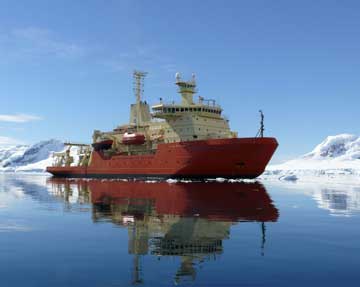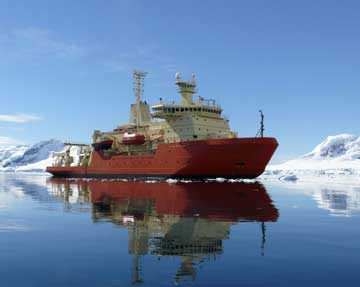 “We’re trying to learn what the krill are doing in the environment, their swimming and schooling patterns, and what prey they are eating,” said Ted Durbin, the professor at the URI Graduate School of Oceanography who led the expedition. “Krill are a keystone species in Antarctica. They are the primary diet of most penguins, seals and whales.”
“We’re trying to learn what the krill are doing in the environment, their swimming and schooling patterns, and what prey they are eating,” said Ted Durbin, the professor at the URI Graduate School of Oceanography who led the expedition. “Krill are a keystone species in Antarctica. They are the primary diet of most penguins, seals and whales.”
“We need to understand what the krill eat,” added doctoral student Alison Cleary, “because as the environment changes in Antarctica, what is available for them to eat may change, and that could affect all the other creatures up the food chain.”
Some of the scientists’ work consisted of observational studies using 3-dimensional camera systems developed by Professor Chris Roman to learn about krill swimming behaviors. “We prefer to let the animals tell us what they’re doing rather than make them jump through hoops,” said Durbin, who has spent almost a year of his life aboard research ships around the world studying krill, plankton and fish.
The research team also collected samples of krill on which to conduct feeding experiments in a ship-based laboratory and to calculate how much they eat and what species of prey they prefer in the wild.
While extensive studies have been conducted on krill for many years, Durbin said that there are a surprising number of unanswered questions about their behaviors and movement patterns, including the timing of their migrations and what they feed on during the dark winter months.
Although the research team still has many months of data analysis to go before drawing conclusions, it made a number of interesting observations that shed light on krill ecology. They observed, for instance, dense aggregations of mostly juvenile krill spending the winter months in the bays and fjords close to shore while the adults remained far offshore. But in the summer the juveniles dispersed in small groupings from the coastal waters to the continental shelf, where they feed on phytoplankton near the surface.
They also noticed large phytoplankton blooms that turned the water green. Durbin expected that there would be large numbers of zooplankton feeding on the microscopic plants. “But the zooplankton apparently hadn’t woken up yet from their winter diapause,” he said. “Nothing was eating it except for the krill. That was a surprise to me. The bloom may sink to the bottom and be a reservoir of potential food for krill.”
For Cleary, who had participated in research expeditions to Antarctica twice before, the difference between the summer and winter cruises were literally like night and day. “This year we were in the Antarctic summer, so it was incredible having sunshine all the time,” she said. “It was amazing being able to see the icebergs, mountains and penguins every hour of the day.”
With a great deal of work still ahead, Durbin said the two expeditions provided “a lot of insights about how the ecosystem is functioning and what new questions should be asked. The more we know about krill behavior and their life history, the more we’ll understand how the system will be effected by climate change.”
The research expedition was funded by the National Science Foundation’s Office of Polar Programs.
Caption: The research vessel Nathaniel B. Palmer with a team of URI scientists and students aboard prepares to depart Antarctica in December. (Photo by Ted Durbin.)

